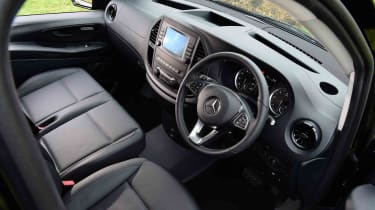Mercedes Vito van review
The Mercedes Vito isn't the newest mid-sized van around, but it is a comfortable and dependable machine
While the Mercedes Vito has been for sale for a while, it still has plenty going for it. This medium-sized machine slots between the small Citan and larger Sprinter, and it offers plenty of space for its size. It also boasts some decent tech, which has been upgraded to keep the Vito competitive with new arrivals such as the latest Ford Transit Custom, and established opponents in the form of the Volkswagen Transporter, Vauxhall Vivaro, Renault Trafic, Citroen Dispatch and Peugeot Expert. The Vito makes a decent case for itself against the competition, although the prestige of a three-pointed star on the nose means it’s not the cheapest van out there.
The current Vito van was introduced in 2014, but updates and a slimming down of the model lineup have helped keep it competitive. Instead of offering diesel versions with front-wheel, the current range consists of rear-wheel drive vans in both L2 and L3 body lengths: only the electric eVito remains front-wheel drive. Panel vans and crew cab options are available, with three- and six-seat interiors.
If you need more seats, then the Mercedes V-Class uses the same bodyshell as the Vito. However, this model is more for luxury executive transport and is of significantly higher quality, so prices are considerably higher.
Used - available now

2024 Audi
A3 Sportback
54,289 milesAutomaticDiesel2.0L
Cash £17,700
2020 Volkswagen
Tiguan
46,057 milesAutomaticPetrol2.0L
Cash £19,950
2025 Audi
Q5
33,511 milesAutomaticPetrol2.0L
Cash £28,850
2018 BMW
2 Series Active Tourer
44,016 milesAutomaticPetrol1.5L
Cash £11,300Cargo volumes for the Vito are 6.0 or 6.6 cubic metres for the panel van, which is competitive with the best medium-sized vans available, while the Crew Van can offer 3.6 or 4.1 cubic metres of space. Unlike some rival vans, the cargo space and passenger compartment are one entity, although Mercedes does offer a bulkhead partition as an option.
Power for the Vito comes from a choice of three diesel engines, plus there's the all-electric eVito, too. All three diesel variants are based on the same 2.0-litre four-cylinder engine and are badged 114 CDI, 116 CDI, and 119 CDI. The 114 CDI makes 132bhp and comes with a six-speed manual gearbox as standard or a nine-speed automatic as an option. The 158bhp 116 CDI and 184bhp 119 CDI come exclusively with an automatic gearbox.
Three trims are available, although which trim you go for determines the engines available to you. Progressive trim kicks off the range with the least potent diesel engine or the eVito electric model, with Premium ramping up the kit and unlocking the mid-range 116 CDI engine. The top-of-the-range Premium Night Edition adds some classy looks to the mix and the most powerful diesel engine. The latter’s extensive upgrades help to bridge the gap between the utilitarian standard van, and the upmarket luxury of the V-Class. Standard Obsidian Black metallic paint with colour-coded bumpers front and rear helps to disguise the crew van layout, because the rear bodywork blends nicely with the dark-tinted rear windows of the sliding doors. There are 17-inch diamond-cut alloy wheels, too, while the grille comes with chrome trim and is flanked by LED headlights that are the same as those found on the V-Class.
Overall, the Vito is a high-quality product, but these days, you're asking buyers to pay a premium for an older van that just so happens to have a Mercedes badge on the nose. That being said, the Vito is an excellent choice if you prioritise comfort, refinement, technology and a general classy feel.
MPG, CO2 and Running Costs
Prices for the Mercedes Vito start at around £30,000 ex.VAT, rising to around £45,000 for the highest-spec, most powerful Crew Van. That might sound like a lot, but if you're looking at a Vito as a passenger-carrying model, then that's a hefty chunk less than you'd pay for a new V-Class. The eVito is more expensive due to its battery tech, and starts from around £48,000.
With the loss of the front-wheel-drive for diesel Vito models, the average fuel economy for the range has taken a knock. The best performer is the 114 CDI manual, which achieves 38.7mpg combined, while adding the auto gearbox sees this figure slip to 38.2mpg.
The mid-range 116 CDI diesel manages 37.6mpg in the official WLTP test, while the 119 CDI engine has a test best of 36.7mpg. In comparison, the extra weight of the Crew Van means fuel economy ranges from 35.8mpg to 37.1mpg, although only the 116 CDI and 119 CDI diesels are offered here.
All vans feature stop-start, low rolling resistance tyres, and aerodynamic panels underneath the van to boost aerodynamic efficiency. There’s also an AdBlue system with SCR exhaust after-treatment tech to help meet the latest emissions standards. That means an AdBlue tank of 24 litres in capacity is fitted, and the van's trip computer will tell you when it needs refilling.
The Vito features a 57-litre fuel tank as standard, so you should be able to travel around 420 miles between fills. Mercedes also offers a larger 70-litre tank as an option, which easily adds another 100 miles of range to that figure, even when using the poorest official fuel economy figures.
The first electric eVito had an official range of 93 miles courtesy of a 41kWh battery, but the current model has a larger 66kWh pack (60kWh useable), so it can travel up to 162 miles under test conditions. Use the van as intended on stop-start urban runs, and there's no reason you won't see that range in everyday use. However, runs at higher motorway speeds will see the range drop significantly. The eVito has a maximum charging speed of 80kW, so a 10-80 per cent charge on a rapid charger will take around 35 minutes, while refilling the battery via a 7kW wallbox charger should take just under 10 hours.
Service intervals on the Vito are up to 25,000 miles or two years. The exact time a service is needed is calculated by the onboard ASSYST computer on an individual basis, considering a whole range of factors. Maintenance and repair costs are reduced by up to 6.4% compared with the old Vito, and the van’s fully galvanised body enables Mercedes to offer a 12-year anti-corrosion warranty.
Load Space and Practicality
Overall, the Vito has decent cargo space, with 6.0 or 6.6 cubic metres on offer, depending on whether you choose the L2 or L3 panel van. This is on a par with rivals, although some, such as the Ford Transit Custom and Renault Trafic, offer taller high-roof vans, which Mercedes does not.
The two panel vans have maximum load lengths of 2,290mm and 2,520mm, but there are maximum floor lengths of 2,831mm and 3,061mm thanks to an opening hatch in the bulkhead that allows longer items to be loaded through to the cabin.
Payloads range from 873-930kg, although some rivals are able to carry more than a tonne. The eVito has a maximum payload of 882kg, although the van's range will be adversely affected if you get anywhere near this figure.
Access to the rear of the van is via a lifting tailgate or twin barn doors – choosing between them is a no-cost option. Beyond that, you get a pair of sliding side doors – not all rivals offer this as standard – while Mercedes offers optional windows for the doors and the steel bulkhead between the load area and cabin.
The Crew Van in L2 guise has 3.6 cubic metres of space, while the L3 Crew Van has a capacity of 4.1 cubic metres. There's a floor length of 1,397mm, or 1,631mm for the L3 version, although long, thin items can slide under the second-row seats if you don't add an optional bulkhead. Payload weights are 781-809kg.
While the Crew Van has a rear bench, the seats are less versatile than those in a typical MPV. They don't fold flat, but you can remove them to create a larger cargo area. However, they come out of the van in a 2+1 configuration and are heavy and difficult to move. Then, you have to figure out where to store them somewhere.
Mercedes offers extras such as floor rails to help tie down items in the back, while wooden flooring is fitted as standard and can be added to the sides of the van to protect the interior.
Reliability and Safety
Mercedes is never shy about piling on the safety kit, and the Vito’s spec list is packed with systems designed to help you avoid incidents.
Driver and passenger airbags are standard on all models, while pelvis and window bags are available as options. Unfortunately, the Crew Van doesn't get any additional airbags for back-seat passengers. Working to prevent those airbags from being needed is Mercedes’ adaptive electronic stability program (ESP) system that includes anti-lock brakes (ABS) brakes, anti-skid regulation (ASR), electronic brakeforce distribution (EBD), a brake assist system (BAS), load adaptive control (LAC), and EUC understeer control, amongst others.
The Vito is particularly adept at towing thanks to the rear-wheel drive layout, and trailer stability assist (TSA) detects the presence of a trailer, adjusting the ESP settings accordingly to prevent fishtailing. The rear-parking camera also has a ‘coupling zoom’ mode, which helps the driver position the towing hitch to connect a trailer.
Mercedes offers adaptive cruise control to keep you at a safe distance from the vehicle in front. There’s also lane keeping assist, which warns the driver if they stray out of their lane without indicating, and a distance warning system that pipes up when you get too close to the car in front. The top-of-the-range Premium Night Edition has intelligent lighting that adjusts the spread and intensity of the high-output LED headlights according to the driving situation. It’s safe to say that a fully-specced Vito is one of the safest vans on the road.
Driving and Performance
As with many mid-sized van rivals, while the Vito dabbled with small-capacity diesel engines in the past, the whole line-up currently uses the same 2.0-litre four-cylinder turbodiesel, just in different states of tune. The larger capacity helps to deliver extra muscle, so every unit is responsive.
The 114 CDI has 131bhp and 330Nm of torque, the 116 CDI comes with 158bhp and 280Nm, while the 119 CDI is a 184bhp unit with 400Nm of torque. All three engines make their maximum torque figure at less than 1,400rpm, and don't need to be worked hard when carrying heavy payloads.
The rear-wheel-drive setup delivers a noticeably more composed feel on the road, and the Vito accelerates smoothly out of corners with good traction – even on slippery surfaces. Around town, the turning circle is 11.8 metres for the L2 van, and 12.5 metres for the L3 version.
The 9G-Tronic auto is an option with the 114 CDI, and standard with the more powerful engines. It’s lifted from Mercedes passenger cars and proves smooth when left to its own devices. You can also change gears using paddles behind the steering wheel, and if you take control, there’s some delay between changes, although they still occur almost imperceptibly. The extra cost of the auto gearbox means it won’t be for everyone, but it is one of the better auto boxes you can get in a van.
Go for the eVito, and there's decent acceleration off the line. It's extremely refined at low speeds, while tyre noise is the biggest issue the faster you go. Heavy use of the accelerator will put pay to the van’s driving range, though.
In general terms, the Vito is comfortable, feeling every bit the solid, substantial product you’d expect from Mercedes vans. The downside is that the generally well-weighted electromechanical steering set-up lacks the feeling of connection to the road you get in the best drivers’ vans. We also find that the foot-operated parking brake takes a lot of getting used to, even with the standard hill hold system. It’s not as bad with the automatic, but pretty tricky to use when equipped with a manual gearbox.
In the Crew Van, the lack of a rear bulkhead dividing the cabin from the cargo area means a lot of road noise reverberates around inside at higher speeds. It's not bad enough to be tiring, but you're aware of its presence. This can be remedied by specifying a full-height bulkhead for around £100.
Cab and Interior
The Vito rolls off the same production line in Vitoria, Northern Spain, as the V-Class passenger carrier, but there are clear differences between the two in the cabin when you clamber aboard – more so than in previous generations.
The Vito gets an entirely different fascia than the V-Class, with Mercedes passenger car plushness replaced by solid, hard-wearing simplicity. The design is a sparse, no-frills effort but comes immaculately constructed. There’s switchgear lifted from the passenger car range (the circular air vents will look familiar, for example), but the plastics are toughened up for commercial applications.
The Vito's infotainment touchscreen is still small at seven inches across, but updates mean it now comes with Apple CarPlay and Android Auto, while Bluetooth and a DAB radio are also standard. Two USB-A sockets are located beneath the touchscreen for connecting devices. Storage options for small items are plentiful, although the narrow door pockets and lack of an overhead shelf mean bigger items will be more challenging to place.
Mercedes also declines to offer the in-built holders for phones and laptops that are available in the Vito’s rivals. It cites safety issues arising from drivers using such technology at the wheel, but if the alternative is holding the phone or balancing a laptop on the passenger seat, bespoke ‘mobile office’ solutions seem preferable. Using an unlined cubby cut in the dash as a phone holder feels half-baked, and will probably lead most drivers to shell out for an aftermarket phone cradle.
The Vito’s interior strengths are its firm but comfortable seats with decent side support and loads of adjustment, including for height. It also offers a lower and more car-like driving position than a Vivaro or Ford Transit Custom.
One of the major plus points of a van-based passenger model is the fantastic views you have of your surroundings, and the Vito is no different. It’s easy to place on the road, while front and rear parking sensors and a reversing camera mean that low-speed manoeuvres are simple, as long as you have enough space to position it.
Mercedes fits a double passenger seat to the Vito, and the cabin is wide enough that it's comfortable to sit three abreast without banging shoulders. The driver gets an armrest to help prevent middle-seat passengers from encroaching on their space. While the driver's seat has a full range of adjustment, it's worth noting that the twin passenger seat is fixed in place, so it doesn't slide or recline. There’s enough leg room for passengers that this shouldn’t be an issue, though.
For the Vito Crew Van, there is a three-seat bench in the back. This offers plenty of space, but it’s fixed in place like the front passenger seat, and doesn’t offer the versatility of being able to fold it down or flip it forward out of the way for more cargo-carrying room. For that, you’ll need to remove them entirely, which is an awkward process.
Pick the Night Edition, and the seats come trimmed with artificial leather, while the driver and outer front passenger seats are heated. Despite this, it's still not as plush as a V-Class, but it's not as expensive as a V-Class, either.
Van dimensions
| Body style | Height | Width | Length |
|---|---|---|---|
| Panel Van L2 | 1,910mm | 1,928mm | 5,140mm |
| Panel Van L3 | 1,910mm | 1,928mm | 5,370mm |
Width including door mirrors: 2,249mm
Load area dimensions
| Body style | Height | Width | Length | Volume |
|---|---|---|---|---|
| Panel Van L2 | 1,391mm | 1,685mm | 2,290mm | 6.0m3 |
| Panel Van L3 | 1,391mm | 1,685mm | 2,520mm | 6.6m3 |
| Crew Van L2 | 1,391mm | 1,685mm | 1,397mm | 3.6m3 |
| Crew Van L3 | 1,391mm | 1,685mm | 1,631mm | 4.1m3 |
















